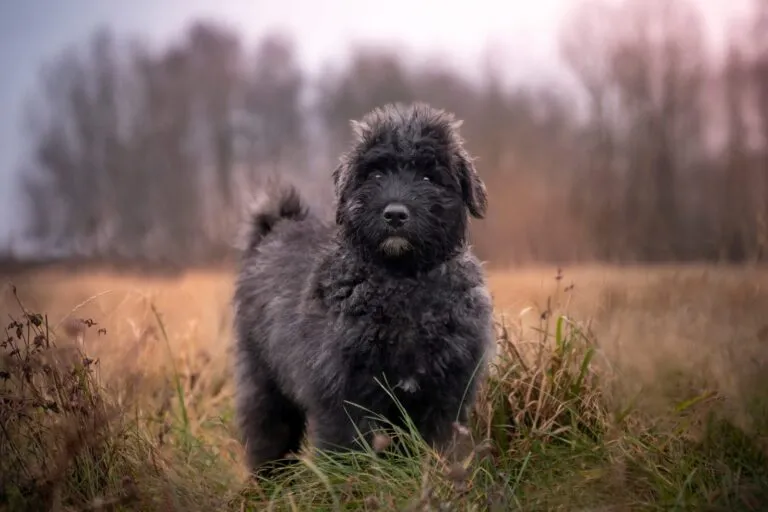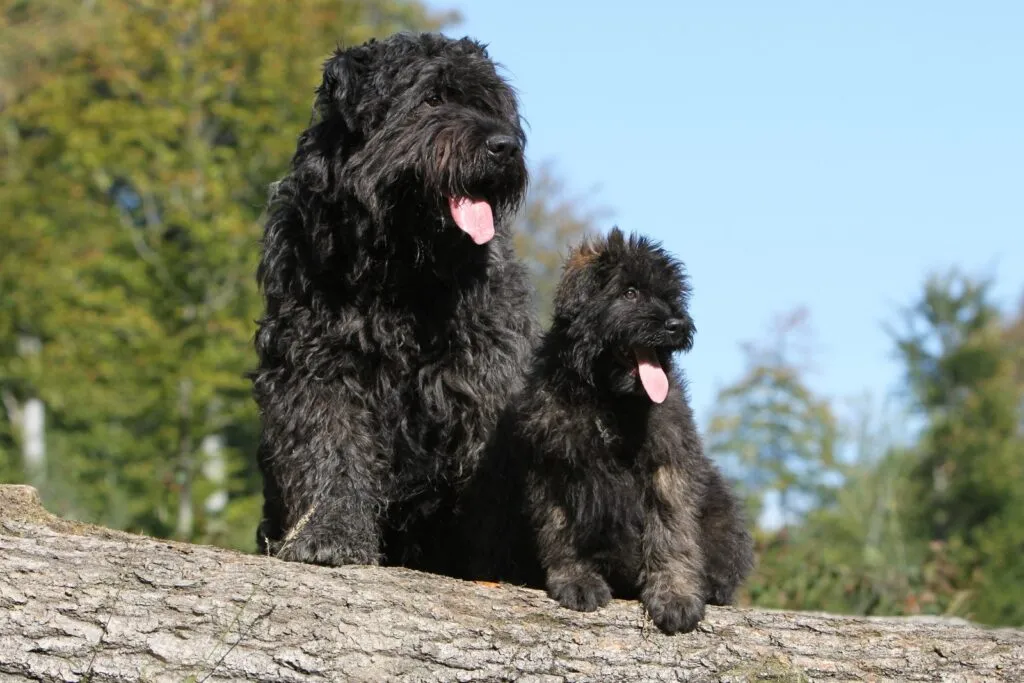Medium Size Poodle
The Bouvier des Flandres, also known as the Flemish Cattle Dog or Vlaamse Koehund, is a Belgian herding dog. It used to herd cows and horses, but today, the "Bouv" is a loyal guard and family dog with a balanced character. However, its long, rough fur does mean a higher amount of care is needed by its owners.

© nitka_zaplatana / stock.adobe.com
With a coarse, weather-resistant coat and calm, stoic nature, the Bouvier des Flandres was bred to drive and protect livestock. Today, this brave and intelligent herding dog makes a devoted companion for experienced families
The Bouvier des Flandres is a large, sturdy dog with a compact build. It has a stocky and robust appearance, without looking clumsy.
Males have a height at the withers between 62 and 68 centimetres, while females range between 59 and 65 centimetres. Their weight spans from 27 to 40 kilograms.
This breed belongs to the late bloomers. Only around the age of three years is the Bouvier des Flandres physically and mentally adult. Characteristic to the “Bouv” is its full beard on the chin and the moustache on the upper lip.
In its Belgian homeland, these features have affectionately earned it the nickname “Vuilbaard”, which translates to “Dirty Beard”.
The long coat of the Flemish Cattle Dog feels brittle, rough and dry. It comes in grey, black variegated or brindle colours. A deep black fur and a white star on the chest are tolerated. According to the breed standard, lighter fur colours are not desired.
The ears of the Vlaamse Koehund are naturally medium-length and hang down. Its tail is set relatively high. Both used to be commonly docked, which is now prohibited in many countries.
The Bouvier des Flandres belongs to the group of herding and cattle dogs. Its original job was to drive and guard large animals such as horses and cows. This is also hinted at in its Dutch name Vlaamse Koehund, meaning Flemish Cow Dog.
To confidently carry out its role as a working dog, the Flemish Cattle Dog developed a calm, balanced, and sometimes almost stoic temperament. Being a protector of cow and horse herds, the dog also needs to make independent decisions, hence it is intelligent, brave – and sometimes stubborn.
Its breed-specific traits make the Bouvier des Flandres an excellent protection and police dog. Additionally, due to its intelligence and fine sense of smell, it is often used as a loyal guard dog and as a tracking dog.
The sturdy canine is also an excellent family pet. The patient “Bouv” usually gets along well with children and accepts other dogs and pets if properly socialised.
 © volofin / stock.adobe.com
© volofin / stock.adobe.com
A large dog like the Vlaamse Koehund, with a strong protective instinct, should be allowed to live in a rural setting. In a house or larger flat with a garden, the Bouvier des Flandres has ample space and can function as a guard dog.
The adventurous, eager-to-learn canine needs to be physically and mentally challenged. In addition to daily walks, it yearns for a task to accomplish – such as being trained as a tracking dog.
Dog sports, particularly draft dog sports, are also ideal for engaging the Bouvier des Flandres in a species-appropriate manner. Historically, the breed was used to move heavy butter barrels. As a so-called tow dog, it also used to pull boats over the water from the shore.
The breed’s ability to move heavy loads remains: these strong animals can pull eight times their own body weight. Agility or obedience are also excellent to keep the intelligent, athletic Bouvier des Flandres busy.
Some dog experience is necessary to train a Flemish Cattle Dog. This dog tends to form a strong bond with its owner, but due to its breed-specific independence, it doesn’t submit as easily as other canines.
Working with it requires patience, consistency and empathy. It’s crucial to make the Bouvier des Flandres recallable early on through training to avoid the risk of it taking off on a walk.
The Bouvier des Flandres’ long, lush coat needs careful attention. It should be trimmed to a length of approx. six centimetres. The coat must be thoroughly brushed daily.
Special attention should be given to your pet’s beard and moustache to remove any food remnants from the “Dirty Beard”. Particularly during the moulting period, it is also essential to free the dense undercoat from knots and tangles.
Furthermore, occasionally check your dog’s paws and carefully trim any hair knots between the pads. The droopy ears of the Flemish Cattle Dog are prone to inflammations and must be checked often as well.
Worth noting: Although coat care is a bit more demanding for this breed, it hardly sheds and develops very little dog-like odour when maintained regularly.
A large, robust dog like the Bouvier des Flandres needs a mineral and vitamin-rich diet. It should be divided into several small portions throughout the day to prevent the life-threatening risk of gastric torsion.
Many dogs of this breed are also enthusiastic about biologically species-appropriate raw feeding, known as Barf. Anyone considering this particular feeding method should first familiarise themselves with the precise ingredients of the meals and seek advice from a veterinarian if in doubt.
Like many other large breeds, the Flemish Cattle Dog is prone to hip dysplasia, a congenital malformation of the hip joint leading to painful mobility restrictions. Eye problems such as cataracts are also possible.
Overall, however, the Bouvier des Flandres is considered an original, relatively hardy breed.
 © Dogs / stock.adobe.com
© Dogs / stock.adobe.com
Animals from reputable breeding and living in species-appropriate conditions can reach an age of up to 15 years.
The heritage of the Bouvier des Flandres is reflected in its name. “Les Flandres” is the French term for the region of Flanders in Belgium. There, the stout, bold canine was formerly used as a cattle driver, even fending off wolves and bears.
The breed likely descends from the Molossers that the Spaniards brought to Flanders during the Dutch War of Independence in the 16th century. Over time, these evolved into the sturdy, resilient Flemish Cattle Dog, who courageously and tirelessly protected large livestock.
In 1910, the breed was officially recognised. After nearly going extinct during World War I, uniform breed standards were established in 1922. The breed was subsequently saved through selective breeding programmes.
Although the breed has some admirers, it isn’t particularly fashionable, hence it’s not very common. As a result, the Bouvier des Flandres is rarely found in animal shelters.
Those wishing to purchase a puppy of this breed should therefore visit a breeder. For a healthy puppy from a reputable breeder, dog lovers should expect to pay £1,000 or more.
It’s worth noting that animals from Dutch protection dog breeding lines are often very wary of strangers. They alert when an unfamiliar person enters the property and prepare to defend. In lines from other countries, mistrust towards strangers often manifests as timidity.
Those who can provide an appropriate home with plenty of exercise and challenging activities will find a loyal four-legged friend in the Bouvier des Flandres. Its gentleness, friendliness, and intelligence make the former farm and herding dog a charming companion for active families.
| Quick Facts: | The Bouvier des Flandres is a strong, compact herding dog that primarily guarded horses and cows in the past. Its calm nature also makes it a faithful companion for families. |
| Height at Withers: | Male: 62–68cm, Female: 59–65cm |
| Weight: | Male: 35–40kg, Female: 27–35kg |
| Average Lifespan: | 10-12 years, on occasions up to 15 years |
| Price: | from £1,000 |
| Temperament: | intelligent, friendly, family-oriented, gentle, patient, rational |
| Fur: | long and brittle |
| Fur Colour: | grey, black, grey-brown, brindle or variegated |
| Training Effort: | moderate |
| Care Effort: | high |
| Exercise Needs: | high |
| Origin: | Belgium |
Fans of the Bearded Collie agree that those who aren't familiar with this dog breed simply have to get acquainted with it. And those who have experienced how a Bearded Collie bolts across meadows with its flowing fur, how it rolls around full of energy and joy and how it attentively and observantly takes into account its owners wishes become simply addicted to this original dog breed and its unique charm.
The Goldendoodle isn't a breed, but a pairing between Golden Retrievers and Medium or Standard Poodles. Marketed as a low-maintenance dog for allergy sufferers, this hybrid is enjoying increasing popularity amongst dog lovers, similar to the Labradoodle.